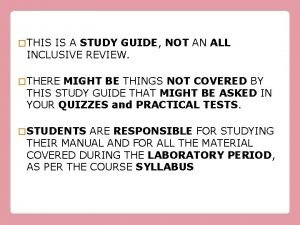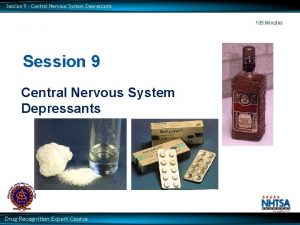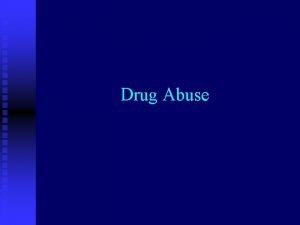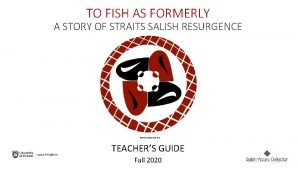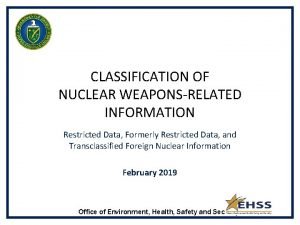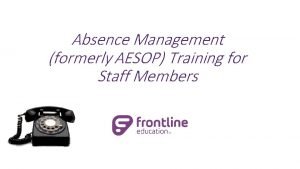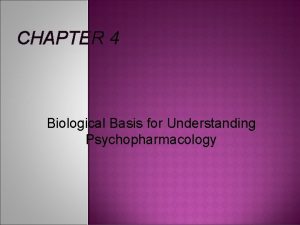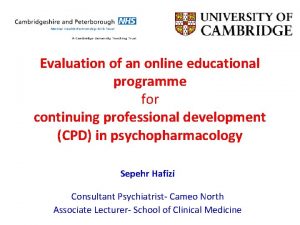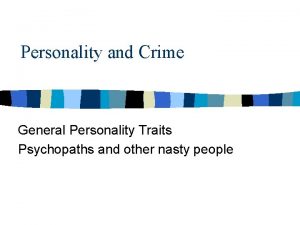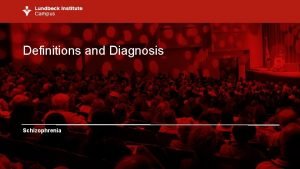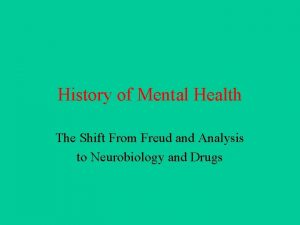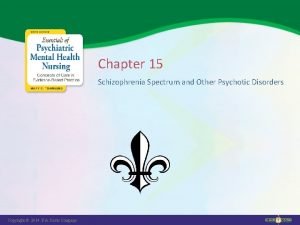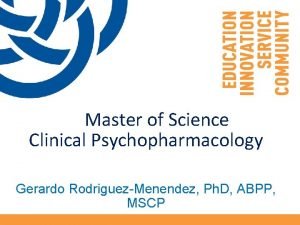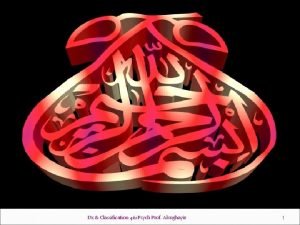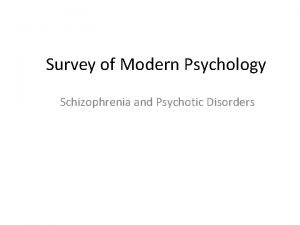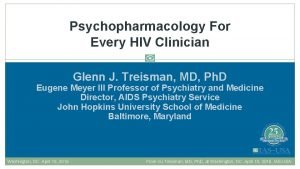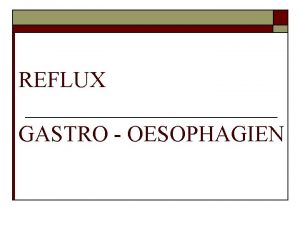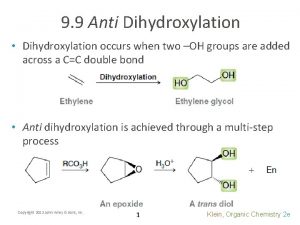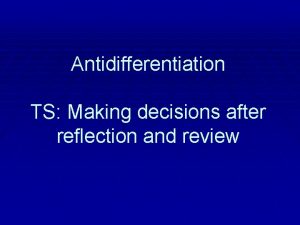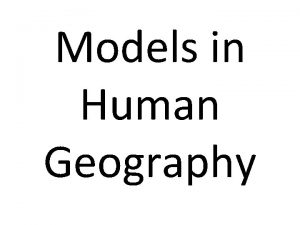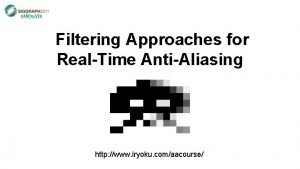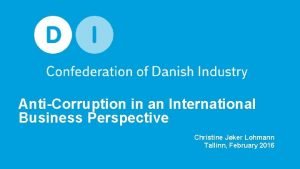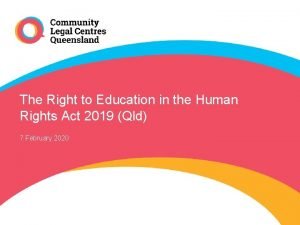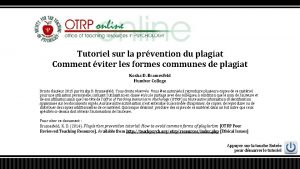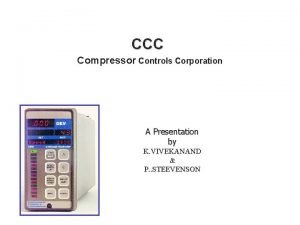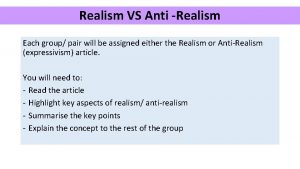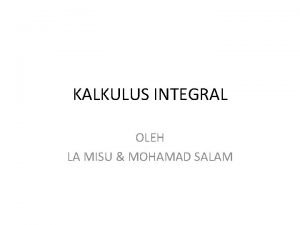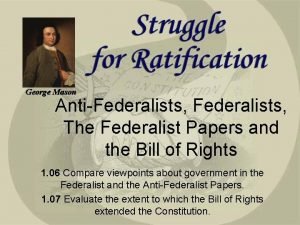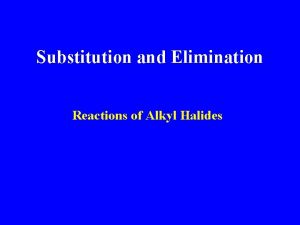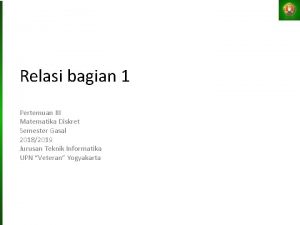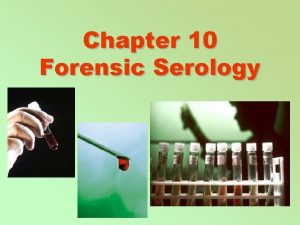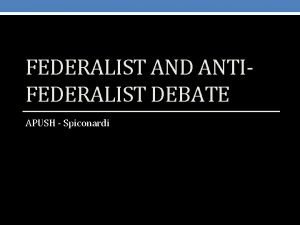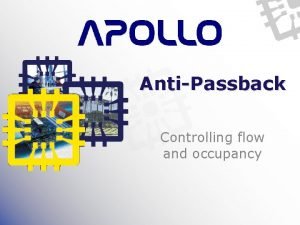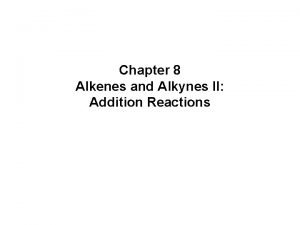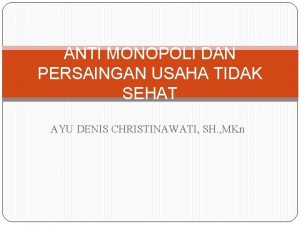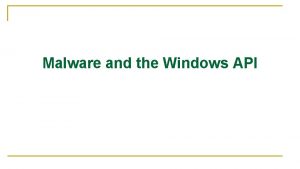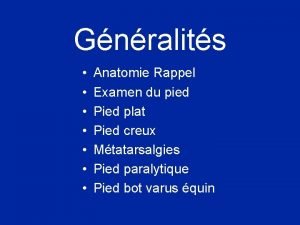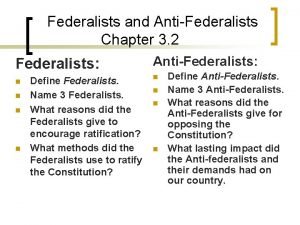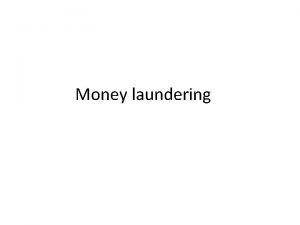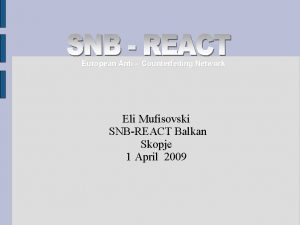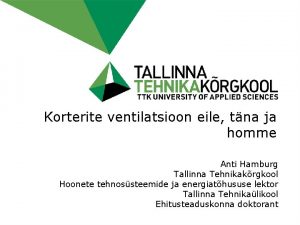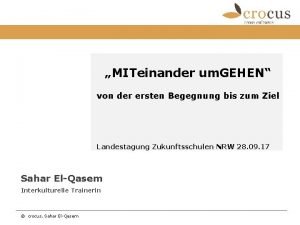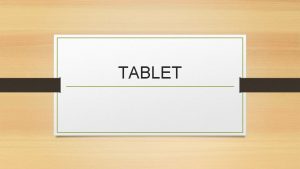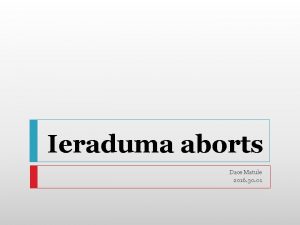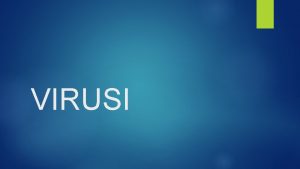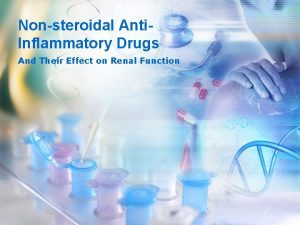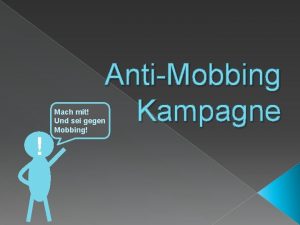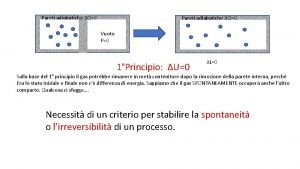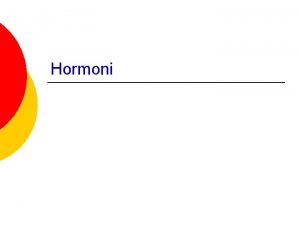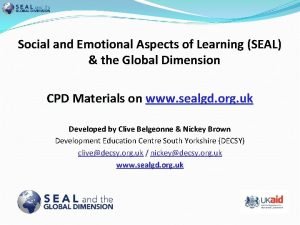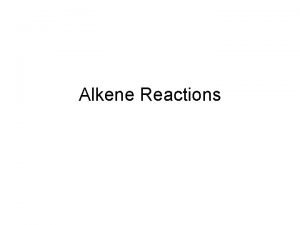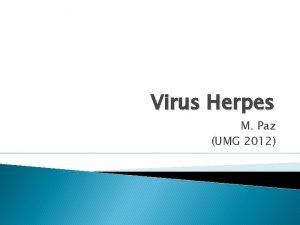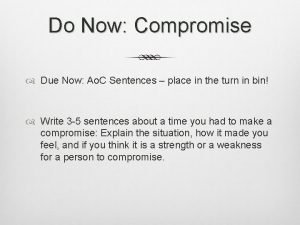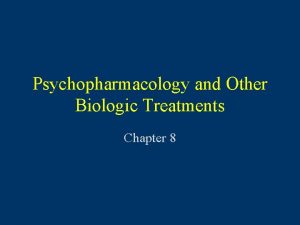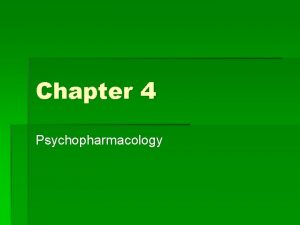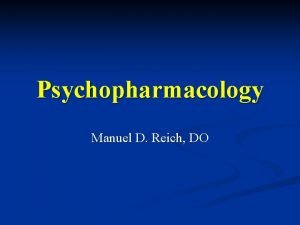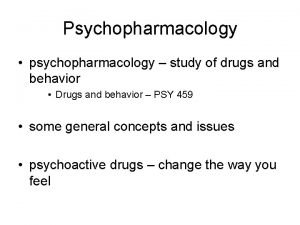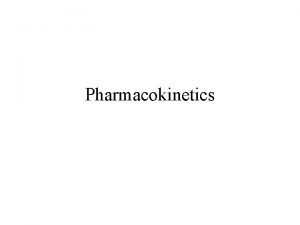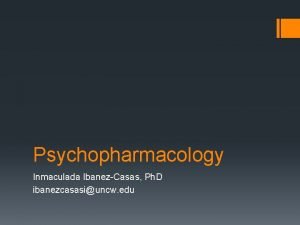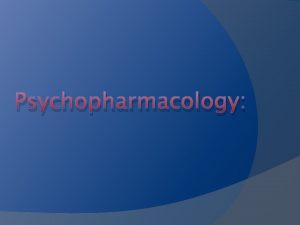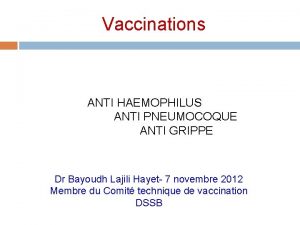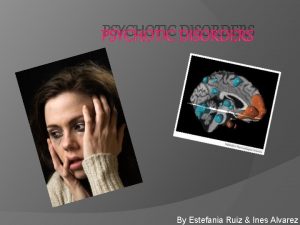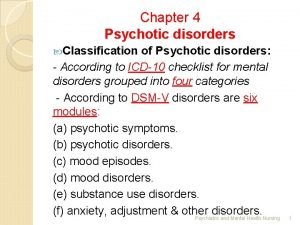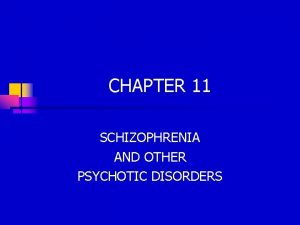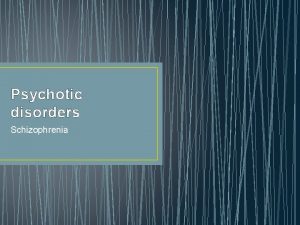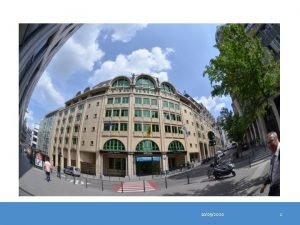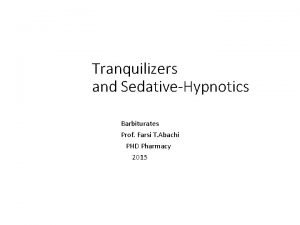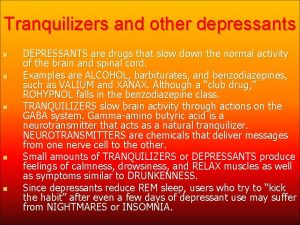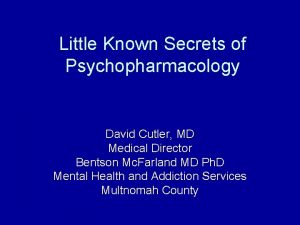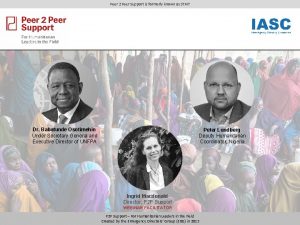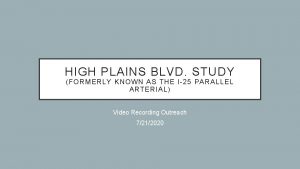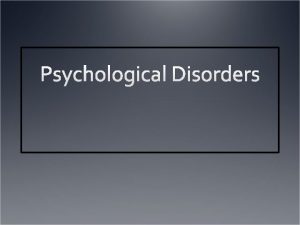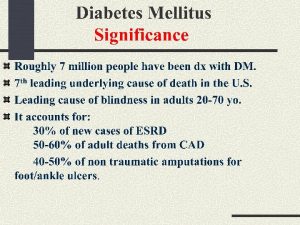PSYCHOPHARMACOLOGY ANTI PSYCHOTIC Formerly known as MAJOR TRANQUILIZERS




























































- Slides: 60

PSYCHOPHARMACOLOGY

ANTI - PSYCHOTIC • Formerly known as MAJOR TRANQUILIZERS; other known as NEUROLEPTIC • Indications – PSYCHOSIS, DELUSIONS, HALLUCINATION. • Blocks receptors of DOPAMINE

TYPICAL ANTI - PSYCHOTICS - Potent blockers of DOPAMINE - Can produce EPS, • Haloperidol ( Haldol, Serenace, ) - tablet, liquid, IV/ IM • Chlorpromazine HCl ( Thorazine – T, L, Laractyl - T) • Fluphenazine Decanoate ( Modezine - , Sydepres)

ATYPICAL ANTI - PSYCHOTICS - weak blockers of dopamine - low S/Es of EPS • Clozapine ( Clozaril, Leponex – T) • Risperdone ( Risperdal – T, L, IV/ IM; Risperdal Consta)

Side effects: • EPS ( Extra Pyramidal Syndrome) 1. a. KATHIsia – Restlessness, inability to sit still 2. a. KINEsia – generalized muscle rigidity 3. Acute DYSTONIA – • Torticollis ( wry neck) • Oculogyric Crisis ( fixed stare) • Opisthotonos ( arched back)

Side effects: Neuroleptic Malignant Syndrome ( NMS) • EARLY SIGNS: - stiffness - fever - diaphoresis - tremors • LATE SIGNS - dysphagia - unstable BP - respiratory depression

Side effects: • Tardive Dyskinesia ( TD) - permanent involuntary movements - lip smacking - tongue protruding - cheeks puffing - S/ Es are IRREVERSIBLE

Side effects: • Anti – Cholinergic Side Effects - dry mouth - constipation - urinary retention • Photosensitivity • Agranulocytosis – fever, sore throat, leukopenia ** Clozapine ( Clozaril) – fewer S/Es but LIFE threatening

ANTI – PARKISONIAN • Used to treat parkinsonian syndrome, dyskinesias to restore neurotransmitters: DOPAMINE & ACETYLCHOLINE. • Anti - Cholinergic action • Dopaminergic agonists – mimicks action of Dopamine

Anti – Cholinergic action • Biperiden HCl ( Akineton) • DI: antagonize action of Metoclopramide, enhance psychotropic drugs. • Levodopa + Carbidopa (Ledocar), (Sinemet) • DI: Anesthesia, MAOIs, Haldol

Dopamine Agonists • Bromocriptine ( Parlodel, Provasyn) • NMS – given in PO • Amantadine ( PK – Merz) – • DI: amiodarone, quinidine, anti – histamine, macrolide anti – biotics.

ANXIOLYTICS • Treat anxiety and anxiety disorders • Insomnia • Benzodiazepines – most effective, also an Anti – Convulsant • Enhances action of Alcohol

ANXIOLYTICS - Benzodiazepines • Diazepam ( Valium), ( Anxiol), - very fast acting, - Tab. , amp. • Alprazolam ( Xanor) - intermediate action • Chlorazepate ( Tranxene) - fast acting

ANTI - DEPRESSANTS • Treatment of major depressive illness • Panic Disorder • Bipolar Disorder • Groups: 1. SSRIs 2. Tricyclics 3. MAOIs

Selective Serotonin Re – Uptake Inhibitors • Treat some personality disorders • Anxiety Disorders • Depression • Increases Serotonin levels • Anti – Cholinergic effect • Fluoxetine ( Prozac), ( Deprizac, Deprexone) • Sertraline ( Zoloft) • Paroxetine ( Seroxat) - Bulimia Nervosa, OCD, Depression

Tricyclic Compounds • TCA ( Tricyclic Anti – Depressants) • ADHD • Anxiety • Smoking Cessation • Schizophrenia • Bulimia Nervosa ** potentially lethal when overdosed • Imipramine ( Tofranil, • Trimipramine (Surmontil) • Clomipramine ( Anafranil) - OCD, Depression, Panic Attacks

MAOIs • Also effective in helping smokers to quit smoking • Depression • Agoraphobia/ Social Anxiety • Potentially lethal diet & drug interaction with SSRI & Tricyclic, Demerol, Tramadol • Hypertensive Crisis • Phenelzine ( Nardil) • Tranycypromine (Parnate) • Isocarboxazid (Marplan) - Stay out of TYRAMINE rich foods: - Wine, cheese, liver

MOOD STABILIZING DRUGS • Treat BIPOLAR DISORDER, Manic State • Most established mood stabilizer • 95% excreted in the KIDNEYS • Renal function tests • Electrolyte – Na ( 135 145 m. Eq/L) • Therapeutic range – 0. 5 to 1. 5 m. Eq/L • Lithium level monitoring – Q 2 -3 days then weekly • S/E: metallic taste, fatigue, polyuria/ dipsia • 3 signs of TOXICITY: - Nausea - Vomiting - Diarrhea • Drug Compliance!

MOOD STABILIZING DRUGS • Carbamazepine ( Tegretol) – • Rashes • Orthostatic hypertension • Clonazepam ( Klonopin) - Acute Mania - Also an anxiolytic with almost same action.

ADHD Drug • Methylphenedate ( Ritalin) • Stimulates neurotransmitters ( Dopamine, Serotonin, Norepinephrine) • Mild CNS stimulation • Reverse effect – calming, slowing of activity • S/Es: anorexia, weight loss, nausea • C/Is: caffeine, sugar, chocolate.

• Disulfiram ( Antabuse) - Px receiving tx for Alcoholism - C/Is: Alcohol, any product with containing alcohol - S/Es: flushing, headache, diaphoresis, N/V, dizziness, halitosis, tremor, incompetence - A/Rs: chest pain, dyspnea, severe hypotension, DEATH - Liver enzyme tests - D/I: Dilantin, INH, Warfarin, diazepam

ANXIETY

ANXIETY vs FEAR • Anxiety – vague feeling of dread • Sense of impending doom • No Identifiable object • Fear – almost the same emotional feelings with anxiety but with identifiable object

LEVELS of ANXIETY 1. Mild Anxiety – - enhance learning - relaxed; slightly restless - attentive - make decisions fast

2. Moderate Anxiety – - pacing - slightly disorganized - “butterflies in the stomach” - urinary frequency - decreased attention span ** may give PRN medication – muscle relaxants

3. Severe Anxiety – - don’t know what to do or say - no direction at all - hyperventilation - gnash teeth - increased diaphoresis - wringing hands - Agitation, Confusion

4. Panic – - SNS activation - Disorganized - Gross motor agitation - Freeze - Distorted thoughts - Cannot solve problems - personality disorganized - out of control, helpless, overwhelmed

• Delusion – fixed, false belief not based in reality • Hallucination – false sensory perception or perceptual experiences that do not exist in reality • Illusion – other known as deception

PHOBIAS • Intense fear of a SPECIFIC OBJECT/ SITUATION • ILLOGICAL • Cause extreme DISTRESS/ PANIC • Pharmacologic Tx. : - Anxiolytics - SSRIs - Propanolol ( Inderal) – beta – blocker to reduce HR & decrease BP

• Psychotherapy - identify anxiety reaction - relaxation techniques - self control - Desensitization – progressive exposure - Flooding – rapid desensitization

OBSESSIVE – COMPULSIVE DISORDER • Obsession – recurrent • Compulsion – thoughts, ideas, behaviors or rituals visualizations, anxiety carried – out to get rid producing of obsessive thoughts or reduce anxiety • Affects interpersonal relationship • Aware of excessive thoughts

• Common Compulsions: - handwashing - counting - checking - touching - arranging/ rearranging - cleanliness

• Psychophramacoligic Tx: - SSRIs – recent drugs indicated to treat OCD - Anxiolytics • Nursing intervention: - frequency of rituals - do not stop px from doing his/her rituals - reduction techniques

POST TRAUMATIC STESS DISORDER • Witness of an extraordinarily terrifying/ deadly event. • Experiences FLASHBACKS, recollection, nightmares • Assessment: Startled, hypervigilance, insomnia Tx: - anxiolytics - anti – depressants - psychotherapy – group or individual therapy - in large groups – CISD

ABUSE & VIOLENCE • Child abuse - physical abuse - sexual abuse - neglect - psychological abuse • Assessment: - burns - bruises • Tx: - ensure safety - social well being - therapy – play, family

• Rape - violence & humiliation expressed through sexual means - sexual intercourse without consent Tx/ intervention: - secure safety - ensure confidentiality - referral to psychiatric, gynecologic management and rape crisis centers - group therapy

SCHIZOPHRENIA • Disease affecting the brain resulting to distorted & bizaare mental, cognitive, emotional, behavioral perceptions.

Types of Schizophrenia • Paranoid Type – persecutory, hostile behavior - feeling of being spied on - grandiose delusions - hallucinations

• Disorganized type – inappropriate or flat affect, loose associations, disorganized behavior • Catatonic Type – psychomotor disturbance, motionless or excessive motor activity, echolalia, echopraxia • Undifferentiated Type – mixed schizophrenic symptoms, with thought, affect, behavior. • Residual Type – social withdrawal, flat affect, looseness of association

Symptoms of Schizophrenia Positive/ Hard symptoms Hallucinations False sensory perception, does not exist in reality Delusions Fixed false beliefs that have no basis in reality Imitation of action form one person Rapid verbalization of one topic to another Verbal repitition of a sentence Echopraxia Flight of Ideas Perseveration

Positive/ Hard symptoms Ideas of reference False impressions Ambivalence Two opposing feelings about the same person, event, situation

Negative/ Soft Symptoms Apathy Alogia Flat affect Blunted affect Anhedonia Catatonia Lack of volition Feelings of indifference to people, events Tendency to speak very little content with little substance Absence of facial expression that would indicate feeling, mood Restricted range of emotional feeling or mood Feeling of no joy or pleasure in life ( work, relationships) Psychologically induced immobility Absence of will, ambition, to accomplish tasks

• Pharmacologic tx: - Anti – Psychotics • Psychotherapy: - Group therapy - Family therapy

Suicide • Common in patients with mood disorders, DEPRESSION • Intentional act of killing oneself • Suicidal ideation – having thought of killing oneself

• - Assessment: Age Sex Marital status Employment Interpersonal relationship - Family background • Factors: 1. - 45 y. o. – older 2. - alcohol dependence 3. - violence 4. - male 5. - depression 6. - loss physical health 7. - singled, widowed, divorced

Evaluation of Suicide Risk High risk Low risk Suicidal Ideation Frequent, intense, Infrequent, low prolonged Suicidal attempt Multiple First Rescue unlikely Rescue inevitalble Self – blame Verbalized anger Method: lethal available Not readily available

Physical Mental High risk Low risk Chronic illness Good health Excessive substance intake Low Severe depression Psychosis Sever personality disorder Substance abuse Mild Neurosis Normal Hopelessness Optimism Social drinker

• Treatment: - Hospitalization - Out – patient management - Pharmacotherapy - Psychotherapy

PERSONALITY DISORDERS • When persons personality traits become inflexible and maladaptive, interferes optimum level of functioning. • Longstanding due to personality characteristics are not easily changed

TYPES Cluster A: Characteristics Odd/ eccentric 1. Paranoid Suspicious, mistrust 2. Schizoid Detached social relationships; involved with things than with people Acute discomfort in relationships, cognitive & perceptual alteration 3. Schizotypal

Cluster B: Appear, emotional, erratic 1. Antisocial 2. Borderline 3. Histrionic 4. Narcissistic Characteristics Unruly, disrespectful, rude Unstable interpersonal relationships, self image, self mutilation Acting-out, manipulative Excessive emotionally attention seeker Need for admiration, grandiose

Cluster C: Characteristics Anxious or fearful 1. Avoidant Social inhibitions 2. Dependent Submissive, clinging behavior Perfectionism, control, orderliness 3. Obsessive – Compulsive

Eating Disorders • • Anorexia Nervosa Life-threatening Refusal to eat Maintain body weight Fear of gaining weight Binge eating Purging • Bulimia Nervosa • Recurrent episodes of binge eating • Purging( self induced vomiting) • Use laxatives • Dental caries, ragged chipped

Complications: • Loss of muscle mass • Hypothyroidism ( weakness, hypoglycemia) • Bradycardia, hypotension • Abdominal pain, diarrhea • Amenorrhea • Anemia, Leukopenia

SUBSTANCE ABUSE • Use of drug in a way that is inconsistent with medical or social norms. • Polysubstance abuse – use of more than one drug. • Intoxication - use of drug resulting to maladaptive behavior • Withdrawal syndrome – negative psychological & physical reactions when drug is stopped abruptly • Detoxification – process of safely withdrawing substance.

• CNS depressants • Sedatives, Hypnotics, Anxiolytics, cannabis, Opioids, , Inhalants, Alcohol • Antidote: Naloxone • CNS stimulants • Amphetamines, cocaine, Hallucinogens

WITHDRAWAL & DETOXIFICATION with CNS Depressants • Tapering of dosage • Symptoms are similar to alcohol withdrawal • Inc. HR, BP, RR • Gastric lavage for overdose PO. • Antidotes are given in severe cases

WITHDRAWAL & DETOXIFICATION with CNS Stimulants • High euphoric feeling, hyperactive • hallucinations • Overdose – seizures, coma, DEATH • Thorazine is given during psychosis

Treatment/ therapy: • • Encourage to join Alcoholics Anonymous Group therapy Contracts Health teaching on client & family members

THE END THANK YOU VERY MUCH
 Anti a and anti rh blood type
Anti a and anti rh blood type Drug recognition expert chart
Drug recognition expert chart Tranquilizers examples
Tranquilizers examples Sxole
Sxole Formerly restricted data
Formerly restricted data Absence management formerly aesop
Absence management formerly aesop Bank alfalah formerly
Bank alfalah formerly Biological basis for understanding psychopharmacology
Biological basis for understanding psychopharmacology Nei master psychopharmacology
Nei master psychopharmacology Psychopath causes
Psychopath causes Dsm 5 vs dsm 4
Dsm 5 vs dsm 4 Cosmetic psychopharmacology
Cosmetic psychopharmacology Associative looseness
Associative looseness Clinical psychopharmacology salary
Clinical psychopharmacology salary Neurosis vs psychosis
Neurosis vs psychosis Types of delusion
Types of delusion Cosmetic psychopharmacology
Cosmetic psychopharmacology Barriere anti reflux
Barriere anti reflux Anti-dihydroxylation
Anti-dihydroxylation What is anti differentiation
What is anti differentiation Range definition ap human geography
Range definition ap human geography Dlaa anti aliasing
Dlaa anti aliasing Xx x
Xx x Anti discrimination act qld
Anti discrimination act qld Reformuler texte anti plagiat
Reformuler texte anti plagiat Ccc anti surge
Ccc anti surge Realism vs anti realism
Realism vs anti realism Anti turunan
Anti turunan Balanced sliding occlusion
Balanced sliding occlusion George mason anti federalist
George mason anti federalist Anti-coplanar
Anti-coplanar Anti simetrik
Anti simetrik Fluoreses
Fluoreses Ratification debate apush
Ratification debate apush Global anti passback
Global anti passback Is acid catalyzed hydration syn or anti
Is acid catalyzed hydration syn or anti Uu anti monopoli
Uu anti monopoli Protech anti skid floor agent
Protech anti skid floor agent Gettickcount anti debug
Gettickcount anti debug Classification of sympatholytic drugs
Classification of sympatholytic drugs Pied creux angle
Pied creux angle Define antifederalists
Define antifederalists Money laundering stacking
Money laundering stacking Eli mufisovski
Eli mufisovski Anti hamburg
Anti hamburg Anti diuretics drugs name
Anti diuretics drugs name Seit unserer ersten begegnung
Seit unserer ersten begegnung Adheren adalah
Adheren adalah Tukša augļa ola simptomi
Tukša augļa ola simptomi Antivirusi wikipedia
Antivirusi wikipedia Anti imflamatory medicine
Anti imflamatory medicine Transverse standing waves
Transverse standing waves Anti mobbing kampagne
Anti mobbing kampagne Pareti adiabatiche
Pareti adiabatiche Tiroksin
Tiroksin Anti bias education
Anti bias education Is acid catalyzed hydration syn or anti
Is acid catalyzed hydration syn or anti Anti vca igg
Anti vca igg Anti federalist rap lyrics
Anti federalist rap lyrics Anti rh antibodies
Anti rh antibodies Balanced occlusion definition
Balanced occlusion definition
